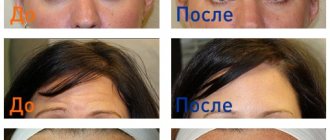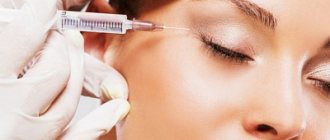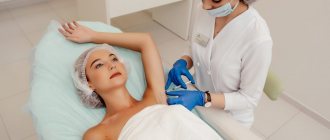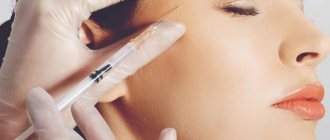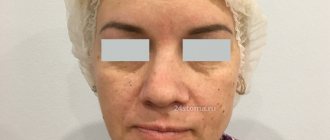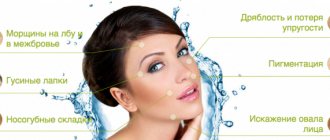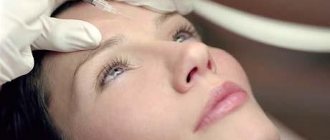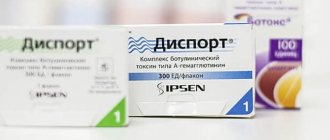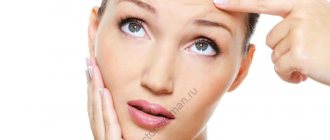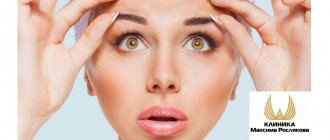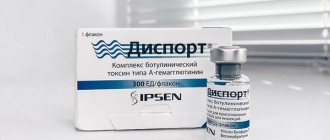Staying in the sun without sunglasses, expressive facial expressions, sleeping face down on a pillow - all this contributes to the appearance of wrinkles under and around the eyes. With the help of massage, eye exercises and proper care, you can slow down the process of their formation. But if wrinkles already exist, they can be completely eliminated only with the help of cosmetic techniques. Botulinum toxin preparations have demonstrated excellent results for many years. By blocking certain muscles involved in facial expressions, Botox and its analogues smooth the skin effectively and for a long time.
Contraindications to the drug
- hypersensitivity to botulinum toxin;
- tendency to allergies;
- diabetes;
- all trimesters of pregnancy, breastfeeding;
- myasthenia gravis;
- high myopia;
- taking anticoagulants and antibiotics;
- bleeding disorders;
- inflammation at injection sites;
- infectious and viral diseases.
Menstruation is not a contraindication to the procedure, however, in the first days of the cycle, the skin is more sensitive and reacts more sharply to irritants. It is better to reschedule injections to more suitable days.
Botox can poison the body
Of course, Botox is a toxin, a weak solution of which is injected into the body. Toxins are poisons. Typically, such a toxin is formed in those mushrooms that are improperly prepared and preserved, and it causes a disease such as botulism. When this substance enters a muscle, it relaxes it, blocks nerve impulses, and they stop being transmitted.
However, the Botox procedure itself is very safe. It is safe due to the fact that the injection is given specifically into a specific muscle, and only into it. In addition, the preparation contains a very low concentration of this poison, it will not be able to spread to other places, it remains only where it was injected. Therefore, if you choose the right dosage, and also inject the drug correctly, then there will be no problems, the procedure will be absolutely safe.
If you listen to the opinion of doctors on this matter, they believe that aspirin and antibiotics are much more dangerous than Botox.
Benefits of the Botox procedure
- the process of deepening wrinkles is stopped;
- new wrinkles do not form in the injection area;
- the skin becomes smooth and even;
- facial expressions remain the same;
- the drug is completely eliminated.
Botox helps correct eye asymmetry and gives you a rested look. It does not accumulate in the body and is eliminated naturally over time. The drug does not interfere with blood circulation and is safe for surrounding tissues.
Cosmetics adhere better to smooth skin after Botox, which gives you self-confidence. Injections against expression lines can be combined with other rejuvenation techniques.
Another plus is that botulinum toxin injections are painless and quick, and the rehabilitation period lasts up to 14 days. There are no traces of injections left on the skin. If the procedure is carried out correctly, others will never notice that you have resorted to the services of a cosmetologist.
What are the disadvantages of the Botox procedure for wrinkles:
• long list of contraindications;
• restrictions during the recovery period; • possibility of allergic reactions; • when injections are abused, disruption of natural facial expressions (“face-mask”). If the doctor violates the protocol for the procedure, asymmetry may occur, which will disappear only after the effect of the drug wears off. Inflammation may occur at the injection sites - this side effect will go away in 1-2 days. Some people report pain at the injection sites, and in older patients, Botox sometimes causes headaches. All this goes away in a couple of days. The pain syndrome can be relieved with painkillers. After the procedure, your doctor will advise you on medications that may be helpful.
If a rash appears in the area around the eyes after the procedure, this may be evidence of an allergy. This unpleasant consequence will soon pass, but in the future you may have to refuse botulinum toxin injections. Be sure to report the rash to your esthetician.
What problems can be solved with Botox?
In modern cosmetology, the drug is used only for the correction of facial wrinkles. Some people mistakenly believe that Botox can enlarge lips, confusing it with intradermal fillers (fillers). With the help of injections of the drug you can smooth out any types of wrinkles on the face:
- horizontal on the forehead (“sage’s wrinkles”);
- vertical eyebrows;
- horizontal on the bridge of the nose;
- in the corners of the eyes (“crow’s feet”);
- above the upper lip (“purse-string wrinkles”);
- on the chin.
Botox is also used to tighten the skin on the neck and décolleté. The final effect of the injections does not appear immediately, but on average 2 weeks after the procedure, but the intermediate result can be assessed after 2-3 days. Botulinum toxin is eliminated from the body naturally within 6–12 months. The more units of the drug are administered, the longer the effect of the procedure will last.
Botox injection
Description of the procedure
If you have no contraindications, the doctor asks you to smile broadly and frown.
Having determined the areas of main muscle activity, the cosmetologist makes markings for the subsequent administration of botulinum toxin. Depending on the clinical situation, the specialist decides to use one or another amount of the drug. For injections, syringes with thin and short needles are used - trauma to the skin during the procedure is minimal. The injection session lasts no more than 30 minutes. After injections, a cold compress is applied to the Botox injection area to reduce swelling. Then you can go home. After the procedure, active facial expressions are recommended to ensure uniform distribution of the drug. A follow-up examination is carried out 14 days after the procedure. During this period you cannot:
- drinking alcohol;
- eat fatty, spicy, salty foods;
- drink plenty of fluids;
- rub injection sites;
- do other cosmetic procedures;
- take a number of medications, such as blood thinners;
- go to the bathhouse and solarium;
- do fitness;
- sunbathing in the sun.
It is advisable not to smoke during the recovery period. You should not use creams or cosmetics for two days after the injections.
Botox and Dysport: is there a difference?
If Botox can be called a veteran of injection plastic surgery, then the drug Dysport is its pioneer. In fact, “Dysport” is a generic (analogue) of “Botox”, which is produced by another brand. They have one active component – botulinum toxin type A + hemagglutinin, diluted to a safe concentration and purified from protein impurities. But the excipients are different: Botox has sodium chloride, Dysport has lactose. There is evidence that the production technologies of these drugs also differ. It is problematic to say with certainty whether this is true or not: manufacturers zealously hide the technological features of the production of Botox and Dysport. Another difference between the drugs is the dosage per bottle, which is determined in units. One bottle of Botox contains 100 units of the active substance, and one bottle of Dysport contains 300 or 500.
A unit of biological activity (IU) is the amount of a drug that contains 3 * 10 7 molecules of botulinum toxin A. When correcting wrinkles, from 2 to 7.5 IU of Botox are injected into one point. The deeper the wrinkles, the more units are spent on their elimination. The number of units is determined individually depending on the type of wrinkles and their severity. To smooth out wrinkles on the forehead, you need from 10 to 30 units of Botox, to remove wrinkles on the neck - 20-50. The total amount of the administered drug should not exceed 250 units per procedure .
Cosmetologists do not have a clear opinion about which drug is better. The choice of one or another composition for injection is a matter of personal preference between the doctor and the client. In the Russian Federation, both drugs are approved for clinical use.
What will be the effect?
After Botox injections into the area around the eyes, you will express emotions in the usual way: widen your eyes, laugh, squint.
Facial expressions will become a little less expressive, but the face will not look like a mask. The injection area will remain motionless. Existing wrinkles will be smoothed out, new ones will not appear. If you are wondering how long a Botox injection for wrinkles lasts, then here is the answer to this question. Botulinum toxin blocks muscles for up to six months. Subsequently, a repeat procedure is required. If you regularly inject Botox or Dysport, the effects will last longer over time. Patients who have been injected with Botox for a long time are subsequently less susceptible to the appearance of facial wrinkles. The muscle gets used to the fact that it is not used, which prevents the formation of wrinkles and creases. In this case, 1 injection session per year is recommended.
How much does a Botox injection cost around the eyes?
1 unit of Botox in our clinic costs 380 rubles. This is a promotional price - for several years now we have maintained the same prices for eliminating expression lines so that you can afford more without harming your wallet.
Botox is a huge stressor for muscles
Here the situation is the other way around. We constantly show emotions, we laugh, we cry, we constantly wrinkle our nose, frown our eyebrows. At this time, our muscles are constantly working, they are constantly tense. This happens even in a dream. Over the years, the situation worsens, the muscles get tired of working.
An example would be you working for a couple of years without a vacation. Naturally, you will be very tired and want to rest. Muscles work without rest for decades. Therefore, you can give them a rest. After a Botox injection, your muscles will relax and will no longer work as hard. Peace will definitely do them good. There is no harm to muscles from Botox.
Rejuvenation cost:
| Botox by zone | Price |
| "Crow's Feet" | up to 12,600 rub. (up to 35 units) |
| Between the eyebrows | up to 12,600 rub. (up to 35 units) |
| Crow's feet + eyebrows | up to 14,400 rub. (up to 40 units) |
The exact cost of the procedure will be announced by the doctor during a face-to-face consultation. We always have Botox and Dysport preparations in stock. The cost of 1 unit of Dysport is 95 rubles. This drug is a full-fledged analogue of Botox.
| Dysport by zone | Price |
| "Crow's Feet" | up to 13,300 rub. (up to 140 units) |
| Between the eyebrows | up to 13,300 rub. (up to 140 units) |
| Crow's feet + eyebrows | up to 15,200 rub. (up to 160 units) |
Our cosmetologists Galina Rakhimovna Sonn, Valentina Andreevna Moiseeva and Natalya Rafaelovna Babajanova are certified specialists in working with Botox and Dysport. Every day there is a cosmetic appointment at the clinic. Make an appointment by phone: +7 (499) 137-00-00
Botulinum toxin and its properties
This is a protein substance, which is considered one of the most powerful poisons of natural origin. But scientists have found that in small doses it is safe for the body and allows you to relieve muscle spasms. Initially, botulinum therapy was used to treat neurological diseases, but one interesting side effect was noticed after the injections: facial wrinkles were smoothed out on the patients’ faces. This was especially noticeable in the folds between the eyebrows and in the corners of the mouth.
This aroused interest among wealthy middle-aged and older women who were ready to do anything for beauty and youth, so there was a high demand for an anti-aging procedure. The effect of botulinum therapy was amazing, so the innovative rejuvenation procedure began to be widely used in cosmetology.
The very first and most famous botulinum therapy drug based on botulinum toxin A (BTA) is Botox.
. For a long time it was the only one, but now there are drugs that include botulinum toxin type B (BTV). Other types of this toxin are not used for botulinum therapy.
To treat diseases associated with muscle spasms, botulinum therapy has been officially used since 1989. The use of Botox in cosmetology was approved in 2002. Since then, cosmetologists have achieved excellent results in the field of rejuvenation. After botulinum therapy, most small facial wrinkles disappear, the face acquires a more welcoming expression due to the smoothing of the folds between the eyebrows.
Injection cosmetology has a wide arsenal of methods used to solve aesthetic and dermatological problems. Quite rare, but their use still leads to negative consequences. The development of complications, as a rule, is caused by the action of active components, violation of technology and safety precautions, especially neglect of sanitation rules, low qualifications of employees or lack thereof.
Since the procedures are, although slightly, invasive, then, as with any manipulations accompanied by a violation of the integrity of the skin, there are certain risks of infectious complications. In the journal “Injection Methods in Cosmetology” No. 2/2018 and 3/2018, we talked about the danger of biofilms - interconnected polymer protective mass of microorganisms, in relation to the development of both early and late complications associated with the introduction of fillers. A recent article published in the Journal of the American Academy of Dermatology presents two illustrative clinical cases of serious infectious complications resulting from injection of botulinum toxin A in healthy people without signs of immunodeficiency - and both cases were associated with Mycobacterium abscessus.
The authors of the article describe two women, 32 and 34 years old, who developed multiple nodules on their facial skin after botulinum toxin injection. In the first case, the injections were performed outside the clinic by a person without medical training. The lesions initially developed as erythematous papules and nodules at all injection sites but gradually progressed to abscesses with ulceration and crusting. Initially, an allergic reaction with secondary impetiginization was suspected, which was treated with prednisone 30 mg/day orally and azithromycin intravenously, but no effect was observed. The lesions recurred a week after stopping prednisone.
In the second case, injections into the masticatory muscle were carried out at a cosmetology center and by a doctor who was not licensed. The patient went scuba diving within the first 48 hours after the injection, and 10 days later, painful, erythematous papules and nodules developed at all injection sites. The lesions also did not respond to intralesional corticosteroids with oral penicillin and gentamicin and wound debridement.
Biopsy and PCR of purulent contents in both cases revealed the presence of Mycobacterium abscessus. The patients were prescribed treatment, including clarithromycin 250 mg twice a day, rifampicin 450 mg once a day (one of the women was additionally prescribed ethambutol 250 mg three times a day), which lasted up to six months. The lesions resolved, but post-inflammatory hyperpigmentation remained, as well as atrophic (in the first case) and hypertrophic (in the second) scars.
As the authors state, there have been no previously reported cases of complications from Mycobacterium abscessus neurotoxin injections. Mycobacterium abscessus is a fast-growing nontuberculous mycobacterium widely distributed in water, soil, and dust that causes infections of the skin, soft tissue, respiratory tract, and central nervous system upon direct contact with contaminated material or water. Most reported cases of this infection have been associated with medical procedures - surgical or cosmetic procedures such as autologous fat injections, mesotherapy, tattooing and hair transplants.
There is no standard treatment for Mycobacterium abscessus, but macrolide antibiotics such as clarithromycin in combination with other antibiotics for at least 4 months are recommended. In some cases, additional surgery may be necessary.
It is important to note that the use of unregistered, illegally purchased drugs, procedures performed in conditions of questionable sterility and insufficient qualifications of personnel carry a huge risk of serious complications for patients, many of which are extremely difficult to treat and leave their marks for life. The authors also draw attention to the potential risk of exposure to sea water during diving (i.e. under high pressure) - there is evidence of the occurrence of mycobacterial skin infections associated with procedures in spa centers.
Read more about news from the world of injection procedures in our magazine “Injection methods in cosmetology”.
Sources: Chen X., Jin Y. et all. Mycobacterium abscessus cutaneous infection secondary to botulinum toxin injection: A report of 2 cases. Journal of the American Academy of Dermatology 2019; 11(5): 982–984. Kothavade RJ, Dhurat RS, Mishra SN, Kothavade UR Clinical and laboratory aspects of the diagnosis and management of cutaneous and subcutaneous infections caused by rapidly growing mycobacteria. Eur J Clin Microbiol Infect Dis 2013; 32(2): 161–188. Nakanaga K., Hoshino Y., Era Y. Multiple cases of cutaneous Mycobacterium massiliense infection in a “hot spa” in Japan. J Clin Microbiol 2011;49(2):613–617.
Botulinum therapy: pros and cons
Let's talk about the pros and cons of botulinum therapy in cosmetology and medicine. This question worries many who want to use the technique. On the one hand, there is extensive experience in the successful use of drugs based on BTA and BTV, but on the other hand, this is a strong poison.
The benefits of botulinum therapy include:
- high efficiency
- quick result
- minimal trauma to the skin
- safety of registered drugs
- duration of effect
- painlessness
- minimum list of contraindications
The content of botulinum toxin in drugs used in botulinum therapy is minimal. The dangerous dose of the toxin is tens or hundreds of times greater than the amount injected during the session, so the injections are completely safe for the body. If you go to a licensed clinic for botulinum therapy and use only registered drugs, you should not be afraid of complications and the development of life-threatening conditions. The result of botulinum therapy will please you, and the general condition of the body will not worsen.
The main disadvantages of botulinum therapy:
- The effect lasts 6-8 months. After this period ends, the procedure must be repeated.
- Only a qualified doctor can perform botulinum therapy correctly. Any mistake can lead to facial asymmetry.
- After injections, swelling may persist for the first days. It is especially noticeable on the eyelids. Swelling after botulinum therapy goes away on its own.
- Facial muscles located next to muscles immobilized by botulinum toxin may become excessively mobile. This leads to the appearance of new facial wrinkles.
- duration of effect
- If injections are abused for rejuvenation, the face can become unnatural and devoid of facial expressions. In everything you need to maintain moderation, because a motionless face without emotions can hardly be called beautiful and natural.
Is botulinum therapy harmful?
If you entrust it to a professional and observe the measure, then no. Some patients, in pursuit of youth, become dependent on beauty injections, try stubbornly to overcome even minor wrinkles, and as a result get a face that resembles a mask. Fortunately, this is reversible.
